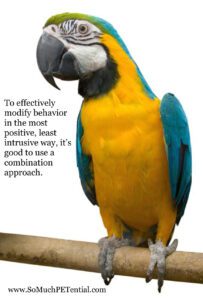(NOTE: This is one of my Hyde Park Living columns.)
Have you ever tried to stop an unwanted pet behavior by simply ignoring it? If it is a behavior that is really difficult to ignore, like a bird’s scream or a dog’s whining, you very well may be among the statistic who complains of  that problem not going away, but instead intensifying.
that problem not going away, but instead intensifying.
Why? What happened?
Well, here is the thing. Screaming and whining are both behaviors that our pets do more of because they have learned that those behaviors cause a positive consequence – human attention. This is called operant learning.
When you then withhold the consequence that reinforces a behavior, the immediate effect is often an abrupt increase in the behavior. Scientifically this is an ‘extinction burst’ and it gives the impression that the behavior problem has worsened. *If* you can effectively continue to withhold that positive consequence, then you would see a steady and fairly rapid decline in the behavior.
However, that is pretty challenging to do when your pet’s behavior is one that is just plain difficult to ignore. And, when you give in and offer attention for the heightened intensity, guess what you have just taught your pet to do *if* he sees your attention as valuable?
Or, you may give in *sometimes*. Sometimes being the key word. An intermittent reinforcement schedule, as it is scientifically referred, causes very strong behaviors because that unpredictability causes resilience.  Think about why humans get so addicted to slot machines.
Think about why humans get so addicted to slot machines.
So, what is a better approach? To effectively modify pet behavior in the most positive, least intrusive way, it’s good to use a combination approach.
- Ignore the unwanted behavior. Period. If your dog is pushing your knee or whining to get your attention, it is best to get up without any eye contact and simply turn away or leave the room.
- Differential reinforcement. While you are ignoring the unwanted behavior, reinforce either an alternative behavior (one that takes the place of the unwanted behavior) or an incompatible behavior ( one that cannot be physically done at the same time as an unwanted behavior – laying on a mat is incompatible with bumping your knee)
- Thoughtfully arrange the environment. If you do not want your dog to bump you when you sit on the couch when you watch tv, some solutions can be putting him in another room or tiring him out with exercise prior to your favorite show so that resting is his more valuable choice.
The best part about solving your problem in this way? You are making learning fun. You are strengthening your relationships with your pet. You are setting yourself and your pet up for success.
Can I be of further help to you and your pet? Please contact me!






